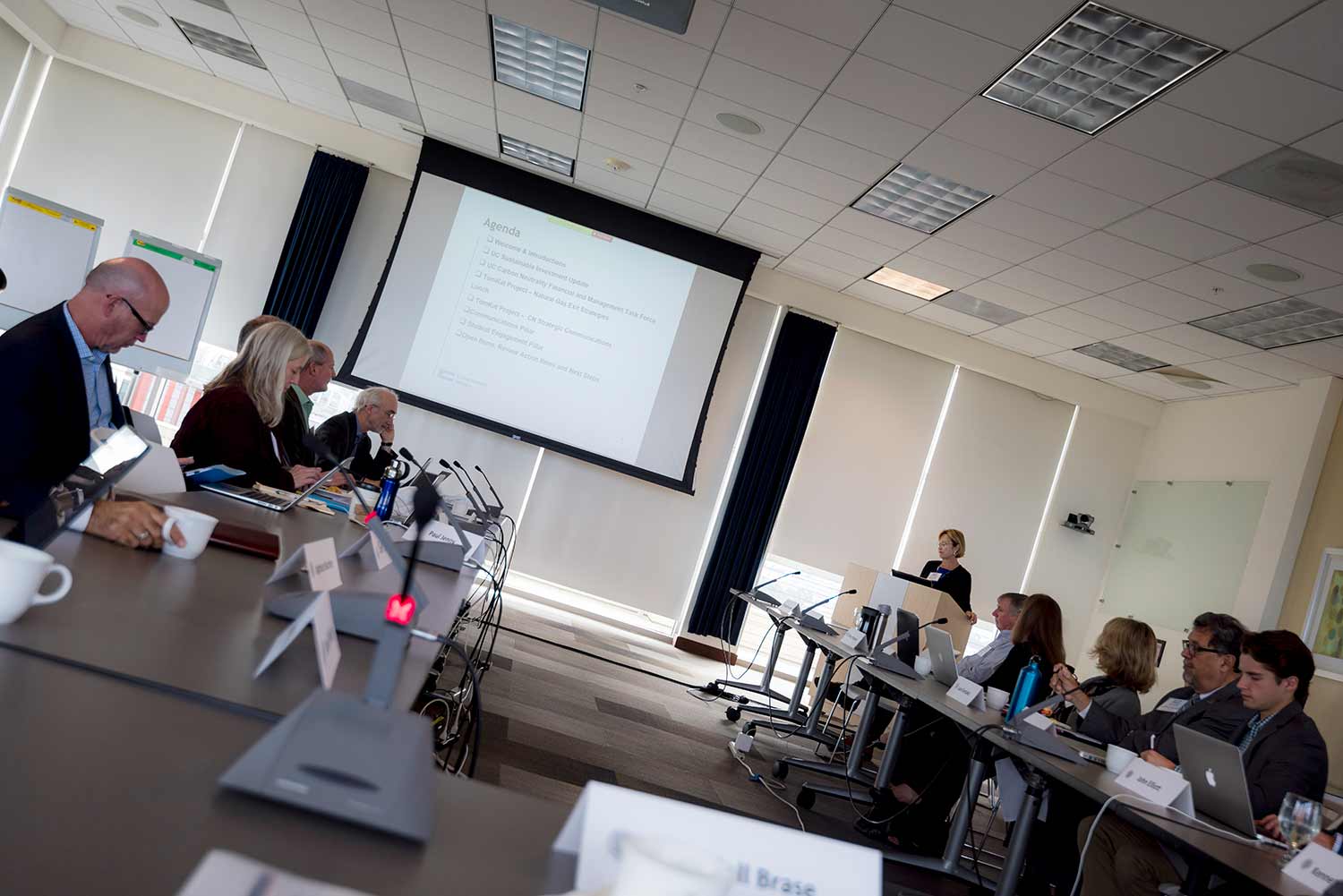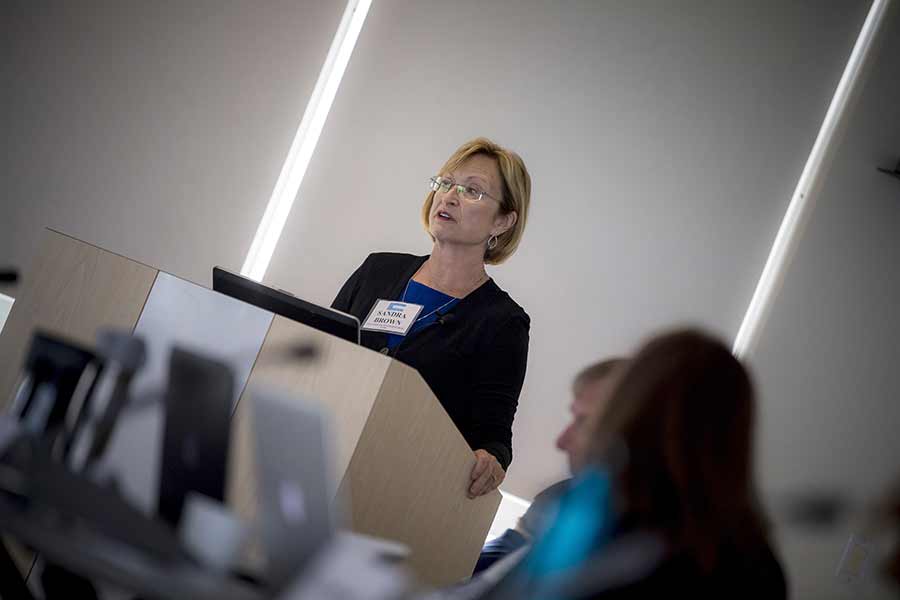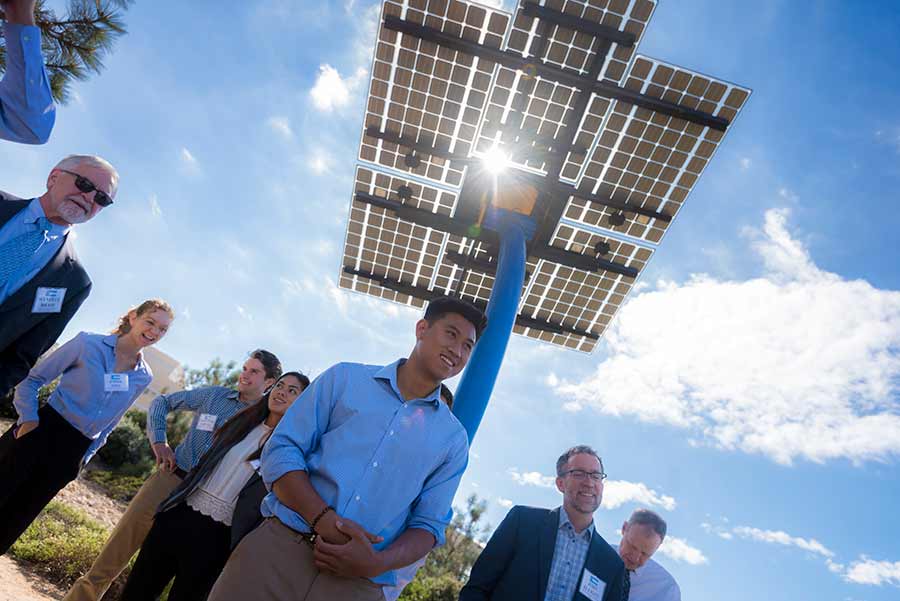
By:
- Kim McDonald
Published Date
By:
- Kim McDonald
Share This:

Photos by Erik Jepsen/UC San Diego Publications
UC Officials Begin Developing Plans to Achieve Carbon Neutrality
Two years after University of California President Janet Napolitano and Gov. Jerry Brown met here with scientists and legislators to set the UC system on its path to become carbon neutral by 2025, many of the details of how to accomplish that ambitious goal still need to be worked out.
Nevertheless, senior officials from the UC President’s Office and UC campuses who gathered at UC San Diego last week to assess the progress made thus far and recommend specific ways for campuses to increase energy efficiency and reduce fossil fuel use were optimistic that the University of California could become the first major research university system to achieve carbon neutrality.
“It’s hard to believe that it’s been two years, nearly to the day, since we held the UC Carbon and Climate Neutrality Summit here on our campus,” said Sandra A. Brown, UC San Diego’s Vice Chancellor for Research and a member of the Global Climate Leadership Council, the high-level UC group meeting here to map out how campuses across the system can achieve carbon neutrality. “But we’ve already made good progress toward our carbon neutrality goals. We aren’t just talk, we’re a lot of action.”

Vice Chancellor for Research Sandra Brown: Many of the UC campuses have “already made good progress toward our carbon neutrality goals. We aren’t just talk, we’re a lot of action.”
“This will take the efforts of every single campus and every single chancellor,” said Nathan Brostrom, Executive Vice President and Chief Financial Officer for the UC President’s Office.
But, added, David Phillips, Associate Vice President for Energy and Sustainability in the UC President’s Office, regarding the council’s preliminary goals: “The good news is that we’re checking these off.”
The motivation to take action is real. Former United Nations climate chief Christiana Figueres has stated that humans have only three years left to bend the rising emissions curve downward if we want to prevent catastrophic climate changes.
This week, representatives from around the world began meeting in Bonn, Germany, for this year’s U.N. climate change meeting to determine how to make good on their nations’ carbon-reduction pledges. Despite President Trump’s threat to pull the U.S. from the Paris climate accord, which seeks to limit global temperature rise to 2 degrees Celsius, Gov. Brown has vowed to keep California on track to meeting our nation’s carbon-reduction goals.
Last week, the governor traveled to Rome with State Senate President Kevin DeLeón and U.S. Rep. Scott Peters for a Vatican climate conference. Also in attendance were UC San Diego’s Wael Al-Delaimy, professor of medicine and chief of the Division of Global Health; Fonna Forman, professor of political science and director of the Center on Global Justice; and V. Ramanathan, director of Scripps Institution of Oceanography’s Center for Atmospheric Sciences, who delivered a lecture on “Ten Solutions for Carbon Neutrality and Climate Solution.”
Vice Chancellor for Research Brown said she was “encouraged that the governor and state legislature have acknowledged the important role of research in meeting the state’s climate goals by adding research to the list of eligible spending areas for cap-and-trade revenues—and then approving an allocation of $11 million in this year’s budget for such research.”

Solar power and other clean sources of energy flowing through UC San Diego’s microgrid generates approximately 85 percent of the electricity used on campus annually.
Participants at the UC San Diego meeting also noted that the La Jolla campus was the appropriate venue for their gathering, because it has long been a model in the UC system for other campuses looking to improve energy efficiency and reduce carbon emissions. Because UC San Diego had set its own goal to achieve carbon neutrality before the UC goal was established, it has already completed a series of innovative projects.
These include the microgrid, which draws utility grid energy from clean sources such as wind and solar power and generates approximately 85 percent of the electricity used on campus annually. This saves our campus more than $8 million a year in energy costs when compared to importing the same amount.
Some of our campus’s most recent steps toward achieving carbon neutrality, according to Brown, include:
- The installation of a 2.5 megawatt/5 megawatt-hour battery energy storage system, one of the largest on any university campus, and 3.8 million gallons of thermal energy storage, both of which reduce the campus’ peak energy demands.
- The completion of more than $100 million in energy efficiency improvements, with nearly another $100 million planned between now and 2025—projects that will save the campus $19 million in annual energy costs.
- The installation of “Vehicle to Grid” charging platforms on 50 new electric-vehicle chargers on campus, made possible through a $4.2 million California Energy Commission grant with the campus’s industry collaborator, Nuvve Corporation. This is important because it allows parked vehicles on campus to become part of the grid as energy storage. UC San Diego’s plan is to expand the number of electric-vehicle chargers to 150 across campus by 2018.
- Providing more than 350 staff and faculty members on campus with discounted electric-vehicle leasing and sales offers, making electric vehicles a more affordable option. The campus is now working with the UC Office of the President to expand these offers to the entire UC system.
UC San Diego was also recently named the academic winner of the International Institute for Sustainable Laboratories first annual National Laboratories Freezer Challenge, a competition designed to persuade researchers to find creative ways to reduce the energy used by laboratory-grade freezers—some of which consume as much energy as a four-person household.
More than 130 laboratories at UC San Diego participated in the contest, said UC President Napolitano in a video presentation to the council, “more labs than any other organization in the country.”
“By taking simple actions, like discarding old samples, maintaining freezers and refrigerators properly and replacing older freezers with more efficient models, these labs will save an estimated 500,000 kilowatt hours,” she added. “That’s equivalent to taking nearly 80 passenger vehicles off the road for one year.”
Karl Brown, deputy director of the California Institute for Energy and Environment, based at UC Berkeley, conducted a preliminary study of how the UC campuses could achieve carbon neutrality system-wide and determined that they could achieve an 84 percent reduction in carbon use through the widespread use of renewable sources of biogas, cogeneration plants, on-site solar and improvements in energy efficiency.
“The combination will vary from campus to campus,” he said, but the key is finding ways to improve energy efficiency through the design of more energy-efficient new buildings and retrofitting buildings to make them more efficient. Tapping into natural methane sources that otherwise escape into the atmosphere from landfills and agricultural waste, or biogas, he said, would be another major way to meet the 2025 goals as well as purchasing electricity produced by decarbonized power sources.
Given the size of the UC system—with 10 campuses, 260,000 students, 21,200 faculty members and 144,000—this effort toward carbon neutrality will not only be a model for how the rest of the nation and world can decrease emissions, but is already helping to foster new industries to do that.
“The University of California is playing a big role in creating a market for biogas,” Brown said.
Share This:
You May Also Like
Stay in the Know
Keep up with all the latest from UC San Diego. Subscribe to the newsletter today.


